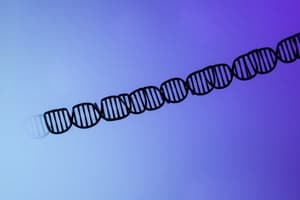Podcast
Questions and Answers
What is the primary function of polar microtubules during cell division?
What is the primary function of polar microtubules during cell division?
- To pull sister chromatids apart during anaphase
- To interlock with polar microtubules from opposite poles to push spindle poles apart (correct)
- To reform the nuclear envelope during telophase
- To shorten and pull sister chromatids towards the poles during metaphase
What is the result of mitosis occurring without cytokinesis following?
What is the result of mitosis occurring without cytokinesis following?
- Formation of a haploid cell
- Increased cellular differentiation
- Formation of a syncytial blastoderm
- Formation of a coenocyte (correct)
During anaphase, what happens to the centromeres?
During anaphase, what happens to the centromeres?
- They split simultaneously (correct)
- They duplicate
- They disappear
- They move to the poles
What is the purpose of cell cycle checkpoints?
What is the purpose of cell cycle checkpoints?
What is the term for the process by which a fertilized Drosophila egg undergoes 13 rounds of mitosis without cytokinesis?
What is the term for the process by which a fertilized Drosophila egg undergoes 13 rounds of mitosis without cytokinesis?
What is the primary function of the G1 phase in the cell cycle?
What is the primary function of the G1 phase in the cell cycle?
What is the main function of the kinetochores during mitosis?
What is the main function of the kinetochores during mitosis?
Which type of microtubules extends from the centrosome towards the cell periphery during mitosis?
Which type of microtubules extends from the centrosome towards the cell periphery during mitosis?
What is the primary function of the centrioles in the cell?
What is the primary function of the centrioles in the cell?
What is the term for the phase of the cell cycle where cells stop dividing and arrest?
What is the term for the phase of the cell cycle where cells stop dividing and arrest?
Flashcards are hidden until you start studying
Study Notes
Cell Cycle
- The cell cycle is a repeating pattern of cell growth and division, where nuclear division divides chromosomes equally into genetically identical daughter cells.
- Cell growth and DNA replication occur between cell divisions.
Interphase
- Consists of three parts: G1, S, and G2 phases.
- G1 phase: cell growth occurs, and it is the gap before DNA duplication.
- S phase: chromosomes duplicate to form sister chromatids through synthesis.
- G2 phase: cell growth and synthesis of proteins needed for mitosis occur, and it is the gap before mitosis.
- Most cell growth occurs during G1 and G2 phases.
- Terminally differentiated cells, such as mature neurons, stop dividing and arrest in G0 phase.
Microtubules and Centrosome
- Formation of microtubules occurs in the cytoplasm.
- Centrosome is the microtubule organizing center near the nuclear envelope.
- Centrioles, present in non-plant cells, are the core of centrosome, where microtubules extend from, surrounded by pericentriolar material.
M Phase (Mitosis and Cytokinesis)
- Consists of five parts: prophase, prometaphase, metaphase, anaphase, and telophase.
Prophase
- Chromosomes condense to stop transcription.
- Centrosomes move to opposite poles.
- Nucleoli begin to disappear, stopping ribosome production.
Prometaphase
- Nuclear envelope breaks down.
- Microtubules from centrosomes connect to kinetochores in the centromere of each chromatid.
- Mitotic spindle forms, consisting of astral, kinetochore, and polar microtubules.
Metaphase
- Sister chromatids face opposite poles, lining up on the metaphase plate.
- Forces pushing and pulling chromosomes to or from each pole create a balanced equilibrium.
Anaphase
- Centromeres split simultaneously.
- Kinetochore microtubules shorten, pulling sister chromatids to opposite poles.
Telophase
- Nuclear envelope forms around chromatids.
- Nucleoli reform.
- Spindle fibers disappear.
- Chromosomes uncoil into chromatin.
Cytokinesis
- Cytoplasm divides, beginning during anaphase but not completed until after telophase.
- In animal cells, a contractile ring contracts to form a cleavage furrow.
- In plant cells, a cell plate forms near the equator.
Consequences of Abnormal Mitosis
- If mitosis occurs without cytokinesis, it leads to multi-nucleated cells.
- Syncytium: multi-nucleated cells, usually early in development.
- Coenocyte: multi-nucleated cells other than early development.
Cell Cycle Checkpoints
- A system of sensor proteins recognizes abnormalities or damage to cells or DNA.
- If damage is detected, the cell cycle stops temporarily to allow repair.
- If damaged beyond repair, the cell undergoes apoptosis (programmed cell death) or senescence (permanent cell arrest).
- Cancerous cells are mutated, with uncontrolled growth.
Studying That Suits You
Use AI to generate personalized quizzes and flashcards to suit your learning preferences.




